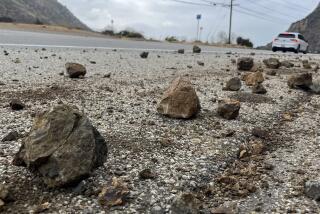Adventures the kids can totally dig
- Share via
A new exhibition in Santa Ana is fueling a faux fossil-finding fascination, while the real boney deal is still going strong in a sticky little pit in the Miracle Mile.
Indeed, the new Dino Quest exhibit at the Discovery Science Center introduces kids to concepts and elements surrounding a simulated archeological excavation -- and that exposure just may spark more interest in what honest-to-goodness scientists are uncovering and ungooing at Pit 91 at the Rancho La Brea Tar Pits.
After all, ancient bones -- real or fabricated -- can still elicit wide-eyed wonder.
The new Science Center exhibit is essentially a big interactive video game, with players exploring a replicated 12,000square-foot archeological dig. Going on a paleontological scavenger hunt, miniature Indiana Joneses are armed with high-tech transmitter wands and search the site to find specific elements of their chosen missions.
“It’s like school, but with more fun,” says Jodie McKay, 11, who was playing detective one afternoon with her younger brother and friends. “It’s neat to use the wand to find the fossils.”
Jodie and gang are having “the time of their lives,” says the mom-on-duty, Lisa Book of Fullerton. “I started to help them, but they were so much into it, I just let ‘em go. We’ve been here almost two hours and I think they are on their third or fourth mission.”
Designed primarily to teach basic life science, the six missions involve topics such as predator-prey relations, habitats and how animals evolved for survival. Via video monitors, players “help” professor Digwell and colleagues complete their research expeditions by finding certain items, such as a raptor tooth or a plesiosaurus flipper.
After five missions are finished, lucky participants have the option of either rescuing and training a baby triceratops or tracking down an escaped T. rex that’s conveniently running amok on a video screen inside a nearby cave.
“We’re finding that it takes about four hours to get all the way through it,” says Janet Yamaguchi, the museum’s vice president of education, who adds that even doing just one mission can be satisfying. In fact, exhibition areas can be enjoyed even without playing the game.
“But once they start, many want to continue,” she adds. “They want to go to the next level, like you do in video games.”
To simulate an authentic archeological dig for the exhibit, Yamaguchi says, she did extensive research, as well as pick the brain of world-class bone finder Luis Chiappe, director of Dinosaur Institute at the Natural History Museum of Los Angeles County. Chiappe helped with the creation of a towering figure in the display -- a life-size Argentinosaurus that illustrates digestion and respiratory systems.
The exhibit also features bones and teeth scattered among rock walls, embedded in posts and hidden inside giant clam shells.
Insects are encased in amber, footprints, plant fossils and even replicas of dinosaur dung and stomach stones.
Yamaguchi is particularly proud of their re-creation of a 1971 famed fossil discovery in the Gobi desert in which a velociraptor and a protoceratops are locked in a deadly embrace. “It’s all done to scale,” she says of the two 80-million-year-old action fighters.
WHILE the scene depicts a dig that could happen in Argentina, Korea or even South Dakota, none of the exhibit’s critters -- or critter pieces, for that matter -- are native Southern Californians.
For that, time has to fast forward some millions of years from the dinosaur-laden Mesozoic era to the late Pleistocene Ice Age when ocean waters receded and dire wolfs, ground sloths and mastodons roamed Wilshire Boulevard.
Yes, Rancho La Brea was certainly rocking some 12,000 to 40,000 years ago when the neighborhood watering hole became a death trap for thousands of creatures that got helplessly stuck in its mucky asphalt pools.
Today, the remains of these beasts are being discovered in one of the most active urban archeological sites around. With the first discoveries in 1875, the tar pits have yielded more than a whopping 3 million fossil items that represent more than 650 species of animals and plants.
Throughout years of excavation, other pits have been tapped for their treasures, but now only one -- Pit 91 -- is the scene of paleontological action. During the summer months, scientists and volunteers don their dirtiest clothes, go down 13 feet and enter a steamy asphalt netherworld.
“The biggest difference between our dig and other digs is that we don’t have to do a lot of pounding or jack-hammering because we have this wonderful preservation agent,” says John Harris, chief curator who describes the tar-like substance as “sandy fudge.”
From an observation deck, visitors can watch excavators recover an estimated 1,000 bones from the bubbling ooze each summer. Walk over to the nearby George C. Page Museum and watch lab folks clean, polish and catalog items as big as saber-toothed jawbones to tiny seed microfossils.
While large bones are still being recovered, lab supervisor Shelley Cox says that the interest today has been on microfossils that are giving clues about climatological changes.
“We’re very interested in finding out what kind of plants grew here, what the weather was like and the general environment these creatures lived in,” she says, adding that L.A. used to be a cool and humid place.
Just down the hallway from the lab, Cox points to a 20,000-square-foot underground storage space where the prized fossils are housed.
“I bet most people don’t realize what they are walking on up there,” she says. “It’s more than a century of work and discoveries -- and there’s still way more to come.”
*
Dig this
Dino Quest
Where: Discovery Science Center, 2500 N. Main St., Santa Ana
When: 10 a.m. to 5 p.m. daily
Price: $12.95, adults; $9.95, ages 3-17
Info: (714) 542-2823; www.discoverycube.org
Pit 91 Excavations
Where: Rancho La Brea Tar Pits, 5801 Wilshire Blvd., L.A.
When: 10 a.m. to 4 p.m. Wednesday through Sunday. Ends Sept. 10.
Price: Free; George C. Page Museum admission is $7, adults; $4.50, ages 13-17; $2, ages 5-12
Info: (323) 934-7243; www.tarpits.org
More to Read
The biggest entertainment stories
Get our big stories about Hollywood, film, television, music, arts, culture and more right in your inbox as soon as they publish.
You may occasionally receive promotional content from the Los Angeles Times.










